RMIT Financial Analytics for Managerial Decisions Hand-in 2
VerifiedAdded on 2023/06/09
|5
|1094
|357
Homework Assignment
AI Summary
This assignment, prepared for BUSM4154 Financial Analytics for Managerial Decisions, addresses two key questions in financial accounting. The first question examines the treatment of gym membership fees at Fitness First Melbourne, arguing for their recognition as a liability when paid upfront due to the service period provided. The second question clarifies the role of depreciation in the cash flow statement, explaining that while depreciation is an expense, it is added back to net profit because it does not involve an actual outflow of cash. The assignment draws on established accounting principles and concepts, providing a comprehensive understanding of financial reporting and analysis.
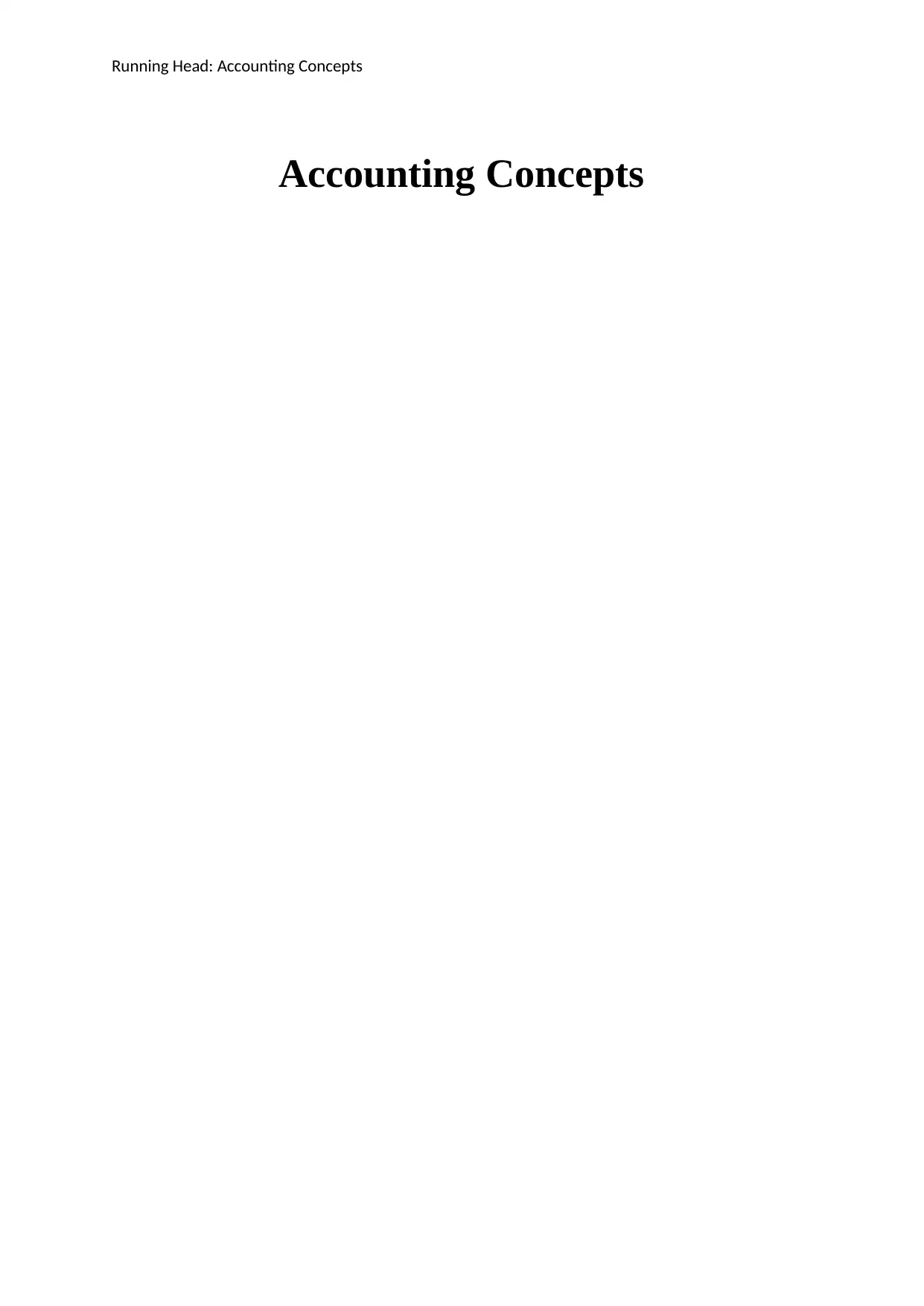
Running Head: Accounting Concepts
Accounting Concepts
Accounting Concepts
Paraphrase This Document
Need a fresh take? Get an instant paraphrase of this document with our AI Paraphraser
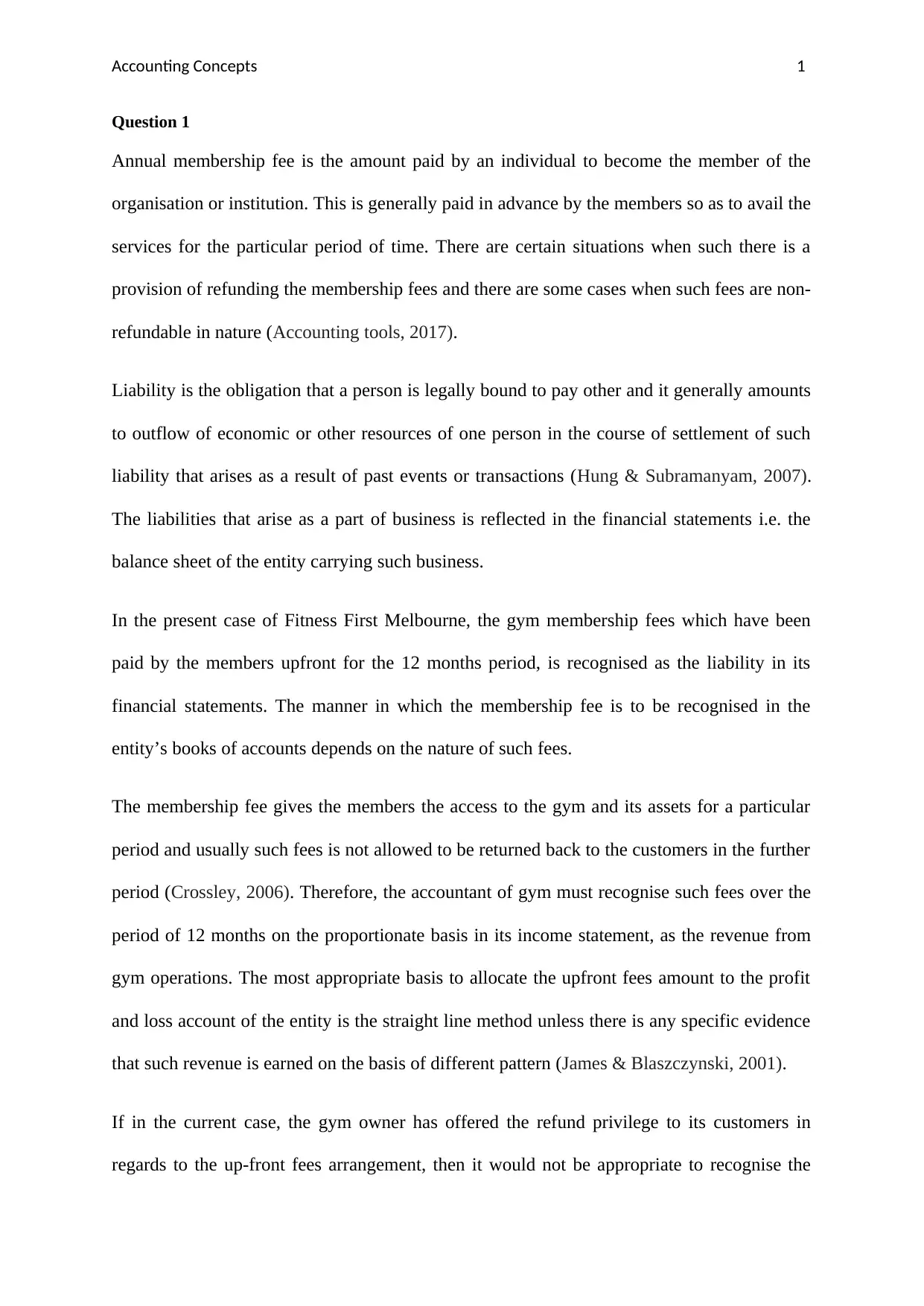
Accounting Concepts 1
Question 1
Annual membership fee is the amount paid by an individual to become the member of the
organisation or institution. This is generally paid in advance by the members so as to avail the
services for the particular period of time. There are certain situations when such there is a
provision of refunding the membership fees and there are some cases when such fees are non-
refundable in nature (Accounting tools, 2017).
Liability is the obligation that a person is legally bound to pay other and it generally amounts
to outflow of economic or other resources of one person in the course of settlement of such
liability that arises as a result of past events or transactions (Hung & Subramanyam, 2007).
The liabilities that arise as a part of business is reflected in the financial statements i.e. the
balance sheet of the entity carrying such business.
In the present case of Fitness First Melbourne, the gym membership fees which have been
paid by the members upfront for the 12 months period, is recognised as the liability in its
financial statements. The manner in which the membership fee is to be recognised in the
entity’s books of accounts depends on the nature of such fees.
The membership fee gives the members the access to the gym and its assets for a particular
period and usually such fees is not allowed to be returned back to the customers in the further
period (Crossley, 2006). Therefore, the accountant of gym must recognise such fees over the
period of 12 months on the proportionate basis in its income statement, as the revenue from
gym operations. The most appropriate basis to allocate the upfront fees amount to the profit
and loss account of the entity is the straight line method unless there is any specific evidence
that such revenue is earned on the basis of different pattern (James & Blaszczynski, 2001).
If in the current case, the gym owner has offered the refund privilege to its customers in
regards to the up-front fees arrangement, then it would not be appropriate to recognise the
Question 1
Annual membership fee is the amount paid by an individual to become the member of the
organisation or institution. This is generally paid in advance by the members so as to avail the
services for the particular period of time. There are certain situations when such there is a
provision of refunding the membership fees and there are some cases when such fees are non-
refundable in nature (Accounting tools, 2017).
Liability is the obligation that a person is legally bound to pay other and it generally amounts
to outflow of economic or other resources of one person in the course of settlement of such
liability that arises as a result of past events or transactions (Hung & Subramanyam, 2007).
The liabilities that arise as a part of business is reflected in the financial statements i.e. the
balance sheet of the entity carrying such business.
In the present case of Fitness First Melbourne, the gym membership fees which have been
paid by the members upfront for the 12 months period, is recognised as the liability in its
financial statements. The manner in which the membership fee is to be recognised in the
entity’s books of accounts depends on the nature of such fees.
The membership fee gives the members the access to the gym and its assets for a particular
period and usually such fees is not allowed to be returned back to the customers in the further
period (Crossley, 2006). Therefore, the accountant of gym must recognise such fees over the
period of 12 months on the proportionate basis in its income statement, as the revenue from
gym operations. The most appropriate basis to allocate the upfront fees amount to the profit
and loss account of the entity is the straight line method unless there is any specific evidence
that such revenue is earned on the basis of different pattern (James & Blaszczynski, 2001).
If in the current case, the gym owner has offered the refund privilege to its customers in
regards to the up-front fees arrangement, then it would not be appropriate to recognise the
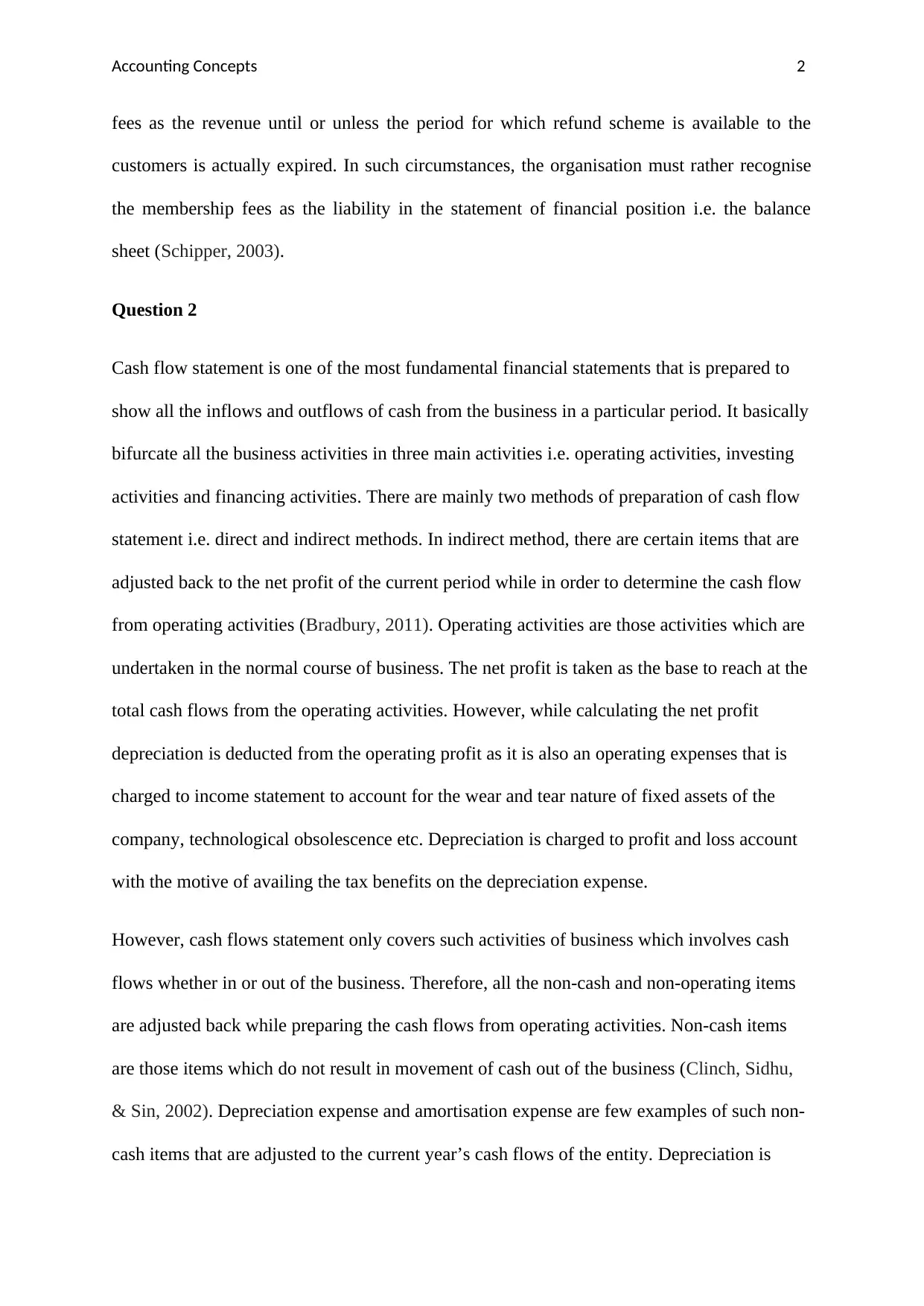
Accounting Concepts 2
fees as the revenue until or unless the period for which refund scheme is available to the
customers is actually expired. In such circumstances, the organisation must rather recognise
the membership fees as the liability in the statement of financial position i.e. the balance
sheet (Schipper, 2003).
Question 2
Cash flow statement is one of the most fundamental financial statements that is prepared to
show all the inflows and outflows of cash from the business in a particular period. It basically
bifurcate all the business activities in three main activities i.e. operating activities, investing
activities and financing activities. There are mainly two methods of preparation of cash flow
statement i.e. direct and indirect methods. In indirect method, there are certain items that are
adjusted back to the net profit of the current period while in order to determine the cash flow
from operating activities (Bradbury, 2011). Operating activities are those activities which are
undertaken in the normal course of business. The net profit is taken as the base to reach at the
total cash flows from the operating activities. However, while calculating the net profit
depreciation is deducted from the operating profit as it is also an operating expenses that is
charged to income statement to account for the wear and tear nature of fixed assets of the
company, technological obsolescence etc. Depreciation is charged to profit and loss account
with the motive of availing the tax benefits on the depreciation expense.
However, cash flows statement only covers such activities of business which involves cash
flows whether in or out of the business. Therefore, all the non-cash and non-operating items
are adjusted back while preparing the cash flows from operating activities. Non-cash items
are those items which do not result in movement of cash out of the business (Clinch, Sidhu,
& Sin, 2002). Depreciation expense and amortisation expense are few examples of such non-
cash items that are adjusted to the current year’s cash flows of the entity. Depreciation is
fees as the revenue until or unless the period for which refund scheme is available to the
customers is actually expired. In such circumstances, the organisation must rather recognise
the membership fees as the liability in the statement of financial position i.e. the balance
sheet (Schipper, 2003).
Question 2
Cash flow statement is one of the most fundamental financial statements that is prepared to
show all the inflows and outflows of cash from the business in a particular period. It basically
bifurcate all the business activities in three main activities i.e. operating activities, investing
activities and financing activities. There are mainly two methods of preparation of cash flow
statement i.e. direct and indirect methods. In indirect method, there are certain items that are
adjusted back to the net profit of the current period while in order to determine the cash flow
from operating activities (Bradbury, 2011). Operating activities are those activities which are
undertaken in the normal course of business. The net profit is taken as the base to reach at the
total cash flows from the operating activities. However, while calculating the net profit
depreciation is deducted from the operating profit as it is also an operating expenses that is
charged to income statement to account for the wear and tear nature of fixed assets of the
company, technological obsolescence etc. Depreciation is charged to profit and loss account
with the motive of availing the tax benefits on the depreciation expense.
However, cash flows statement only covers such activities of business which involves cash
flows whether in or out of the business. Therefore, all the non-cash and non-operating items
are adjusted back while preparing the cash flows from operating activities. Non-cash items
are those items which do not result in movement of cash out of the business (Clinch, Sidhu,
& Sin, 2002). Depreciation expense and amortisation expense are few examples of such non-
cash items that are adjusted to the current year’s cash flows of the entity. Depreciation is
⊘ This is a preview!⊘
Do you want full access?
Subscribe today to unlock all pages.

Trusted by 1+ million students worldwide
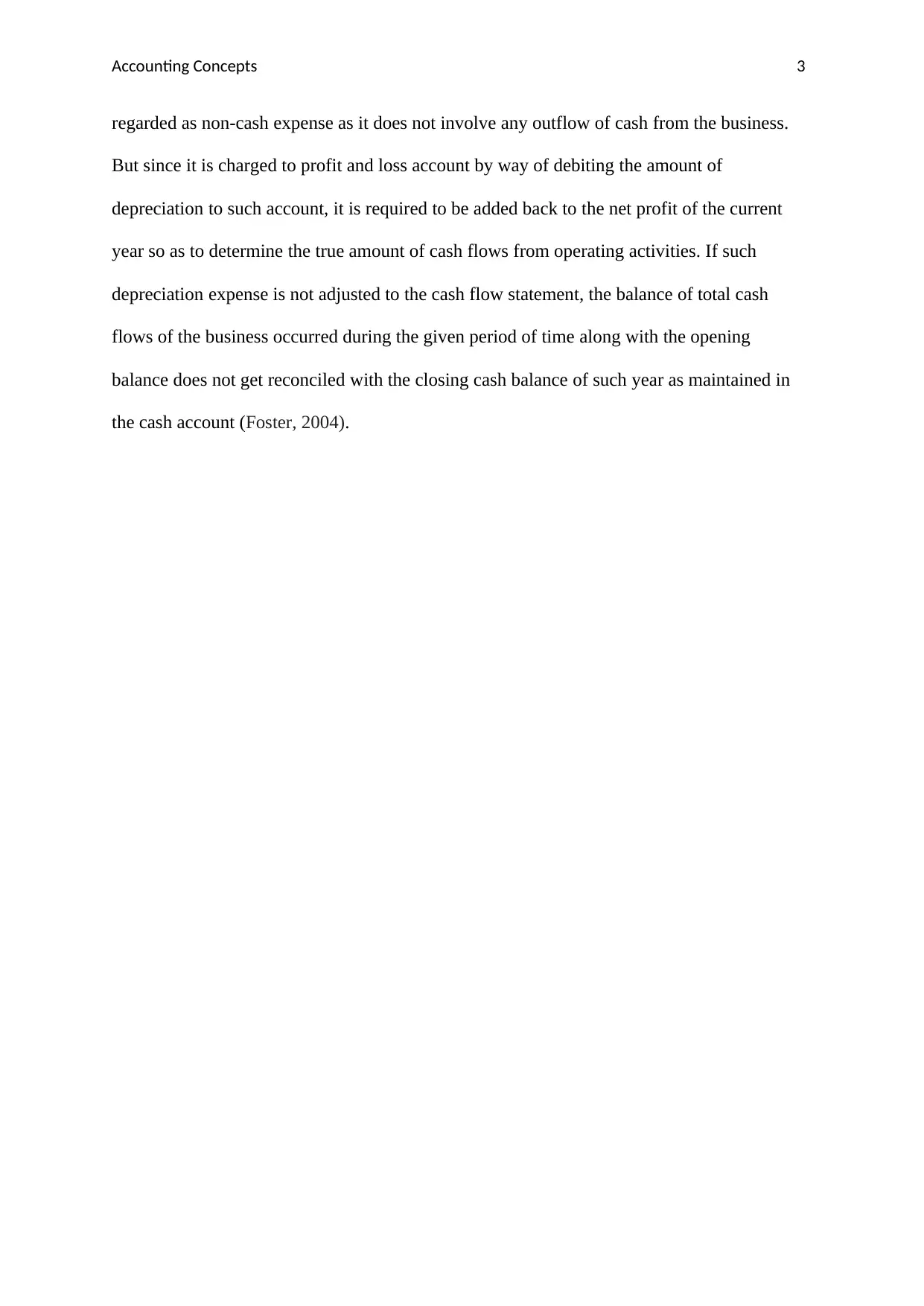
Accounting Concepts 3
regarded as non-cash expense as it does not involve any outflow of cash from the business.
But since it is charged to profit and loss account by way of debiting the amount of
depreciation to such account, it is required to be added back to the net profit of the current
year so as to determine the true amount of cash flows from operating activities. If such
depreciation expense is not adjusted to the cash flow statement, the balance of total cash
flows of the business occurred during the given period of time along with the opening
balance does not get reconciled with the closing cash balance of such year as maintained in
the cash account (Foster, 2004).
regarded as non-cash expense as it does not involve any outflow of cash from the business.
But since it is charged to profit and loss account by way of debiting the amount of
depreciation to such account, it is required to be added back to the net profit of the current
year so as to determine the true amount of cash flows from operating activities. If such
depreciation expense is not adjusted to the cash flow statement, the balance of total cash
flows of the business occurred during the given period of time along with the opening
balance does not get reconciled with the closing cash balance of such year as maintained in
the cash account (Foster, 2004).
Paraphrase This Document
Need a fresh take? Get an instant paraphrase of this document with our AI Paraphraser
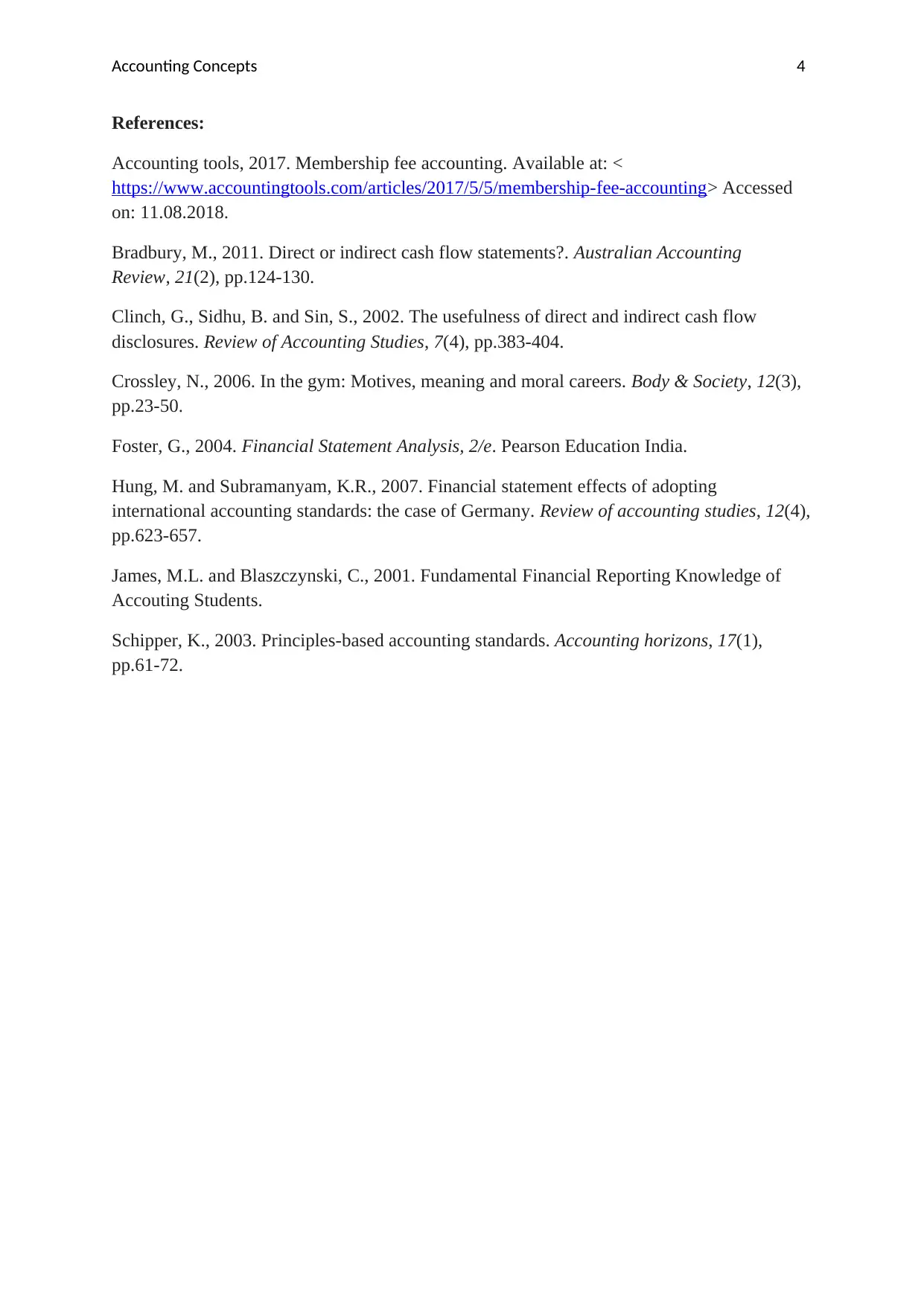
Accounting Concepts 4
References:
Accounting tools, 2017. Membership fee accounting. Available at: <
https://www.accountingtools.com/articles/2017/5/5/membership-fee-accounting> Accessed
on: 11.08.2018.
Bradbury, M., 2011. Direct or indirect cash flow statements?. Australian Accounting
Review, 21(2), pp.124-130.
Clinch, G., Sidhu, B. and Sin, S., 2002. The usefulness of direct and indirect cash flow
disclosures. Review of Accounting Studies, 7(4), pp.383-404.
Crossley, N., 2006. In the gym: Motives, meaning and moral careers. Body & Society, 12(3),
pp.23-50.
Foster, G., 2004. Financial Statement Analysis, 2/e. Pearson Education India.
Hung, M. and Subramanyam, K.R., 2007. Financial statement effects of adopting
international accounting standards: the case of Germany. Review of accounting studies, 12(4),
pp.623-657.
James, M.L. and Blaszczynski, C., 2001. Fundamental Financial Reporting Knowledge of
Accouting Students.
Schipper, K., 2003. Principles-based accounting standards. Accounting horizons, 17(1),
pp.61-72.
References:
Accounting tools, 2017. Membership fee accounting. Available at: <
https://www.accountingtools.com/articles/2017/5/5/membership-fee-accounting> Accessed
on: 11.08.2018.
Bradbury, M., 2011. Direct or indirect cash flow statements?. Australian Accounting
Review, 21(2), pp.124-130.
Clinch, G., Sidhu, B. and Sin, S., 2002. The usefulness of direct and indirect cash flow
disclosures. Review of Accounting Studies, 7(4), pp.383-404.
Crossley, N., 2006. In the gym: Motives, meaning and moral careers. Body & Society, 12(3),
pp.23-50.
Foster, G., 2004. Financial Statement Analysis, 2/e. Pearson Education India.
Hung, M. and Subramanyam, K.R., 2007. Financial statement effects of adopting
international accounting standards: the case of Germany. Review of accounting studies, 12(4),
pp.623-657.
James, M.L. and Blaszczynski, C., 2001. Fundamental Financial Reporting Knowledge of
Accouting Students.
Schipper, K., 2003. Principles-based accounting standards. Accounting horizons, 17(1),
pp.61-72.
1 out of 5
Related Documents
Your All-in-One AI-Powered Toolkit for Academic Success.
+13062052269
info@desklib.com
Available 24*7 on WhatsApp / Email
![[object Object]](/_next/static/media/star-bottom.7253800d.svg)
Unlock your academic potential
Copyright © 2020–2025 A2Z Services. All Rights Reserved. Developed and managed by ZUCOL.




